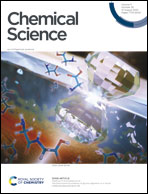Engineering a highly selective probe for ratiometric imaging of H2Sn and revealing its signaling pathway in fatty liver disease†
Abstract
Hydrogen polysulfides (H2Sn, n > 1) have continuously been proved to act as important signal mediators in many physiological processes. However, the physiological role of H2Sn and their signaling pathways in complex diseases, such as the most common liver disease, nonalcoholic fatty liver disease (NAFLD), have not been elucidated due to lack of suitable tools for selective detection of intracellular H2Sn. Herein, we adopted a general and practical strategy including recognition site screening, construction of a ratiometric probe and self-assembly of nanoparticles, to significantly improve the probes' selectivity, photostability and biocompatibility. The ratiometric probe PPG-Np-RhPhCO selectively responds to H2Sn, avoiding interaction with biothiol and persulfide. Moreover, this probe was applied to image H2Sn in NAFLD for the first time and reveal the H2Sn generation pathways in the cell model of drug-treated NAFLD. The pathway of H2Sn revealed by PPG-Np-RhPhCO provides significant insights into the roles of H2Sn in NAFLD and future drug development.



 Please wait while we load your content...
Please wait while we load your content...